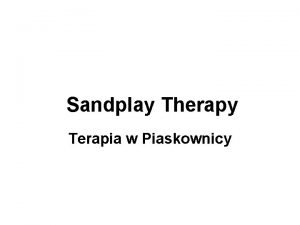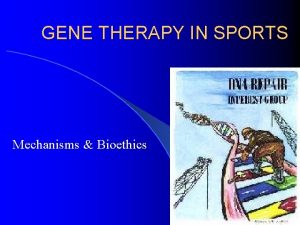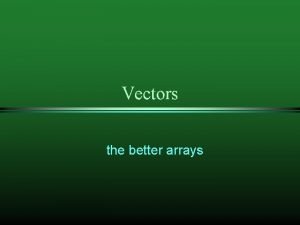Gene delivery vectors Gene Therapy intro Gene therapy







- Slides: 7

Gene delivery vectors

Gene Therapy - intro • Gene therapy has emerged in the late 20 th century • An approach to treat serious human illnesses resistant to traditional therapies. • The basis of gene therapy is to cure genetic diseases by introducing new genetic instructions into the tissues of patients in order to compensate for abnormal or missing genes or to convey a new function (Emery 2004). • Until now, it has proven its usefulness in a number of clinical trials aimed to develop a cure for several inherited and acquired genetic diseases.

• The majority of the gene therapy clinical trials are directed against – cancer, – cardiovascular, – nervous system, – eye or – lung diseases • there are several success stories in these trials (Biffi et al. 2011; Leung et al. 2010; Stieger and Lorenz 2010).

Examples • In X-linked adrenoleukodystrophy (ALD), for example, a lentiviral mediated therapy of hematopoietic stem cells resulted in ALD protein production in two boys and the disease was stabilized or improved (Cartier et al. 2009). • Another clinical study with inherited retinal disease showed that in treated blind children, adeno-associated viruses carrying a normal RPE 65 improved their visual fields (Maguire et al. 2009). • Retroviral transduction of hematopoietic stem cells carrying ADA gene effectively protected eight children against infections and improvement in physical development made a normal lifestyle possible (Aiuti et al. 2009).

• Cancer which is another candidate for gene therapy trials arises as a direct result of genetic mutations. It is one of the leading causes of mortality in the world today. Therefore besides the classical types of cancer therapy such as chemotherapy or radiotherapy, it is feasible to use this novel technology for the correction of this genetic disease (Majhen and Ambriovic-Ristov 2006; Wu et al. 2001).

• A variety of gene delivery vectors have been developed in the last decade and the success of gene therapy is largely dependent on the gene delivery methodology which can be divided into four groups (Giacca 2010; Sakurai et al. 2007; Warnock et al. 2011): • (i) Simple utilization of naked plasmid or short regulatory nucleic acids by local administration. • (ii) Facilitation of nucleic acid entry into the cells by physical methods such as electroporation or sonoporation. • (iii) Transport of nucleic acids into the cells by liposomes or polymers. • (iv) Embedding of nucleic acid sequences within the viral genomes.

• A variety of gene delivery vectors have been developed in the last decade and the success of gene therapy is largely dependent on the gene delivery methodology which can be divided into four groups (Giacca 2010; Sakurai et al. 2007; Warnock et al. 2011): (i) Simple utilization of naked plasmid or short regulatory nucleic acids by local administration. (ii) Facilitation of nucleic acid entry into the cells by physical methods such as electroporation or sonoporation. (iii) Transport of nucleic acids into the cells by liposomes or polymers. (iv) Embedding of nucleic acid sequences within the viral genomes.













